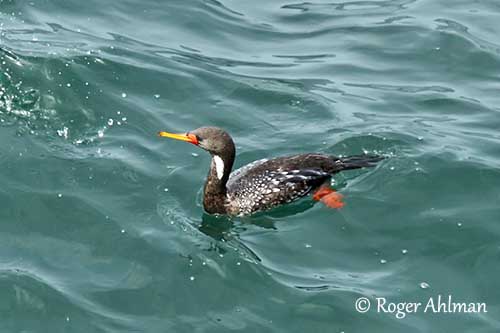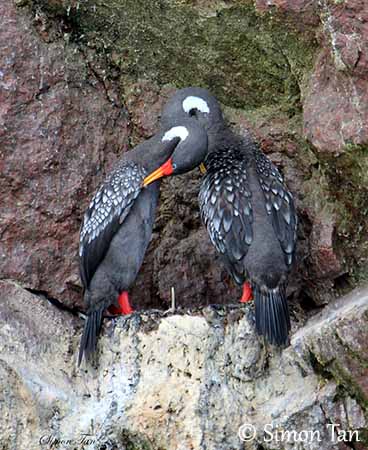
Fr: Cormoran de Gaimard
Ang: Red-legged Cormorant
All: Buntscharbe
Esp: Cormorán Chuita
Ita: Cormorano zamperosse
Nd: Roodpootaalscholver
Sd: Rödfotad skarv
Photographers:
Roger Ahlman
Pbase Galleries Peru and Ecuador
Simon Tan
PBase Bird galleries
Text by Nicole Bouglouan
Sources:
HANDBOOK OF THE BIRDS OF THE WORLD vol 1 by Josep del Hoyo-Andrew Elliot-Jordi Sargatal - Lynx Edicions - ISBN: 8487334105
BirdLife International (BirdLife International)
Birding Patagonia – Adventure expeditions
Neotropical Birds – Cornell Lab of Ornithology
OCEANA – Protecting the World’s Oceans
Wikipedia, the free encyclopaedia
Page family Phalacrocoracidae
Summary cards
Red-legged Cormorant
Phalacrocorax gaimardi
Suliformes Order – Phalacrocoracidae Family
INTRODUCTION:
The Red-legged Cormorant is a South American species, less colonial than most of Phalacrocoracidae. This one nests solitary or in small groups, often on the steep rocky faces of coastal cliffs and islets. Its speckled plumage is a good camouflage when it perches on narrow rocky ledge, although the bright red bare parts make the bird sometimes conspicuous.
The Red-legged Cormorant is a very nice bird, and one of the most beautiful cormorants.

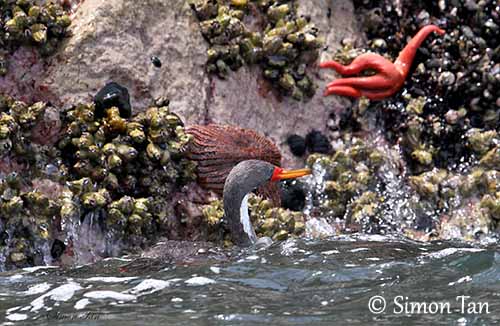
DESCRIPTION OF THE BIRD:
Biometrics:
Length: 71-76 cm
Wingspan: 91 cm
Weight: 1200-1500 g
The adult has grey back and rump. The uppertail-coverts are darker grey with white edges. Wing-coverts and scapulars have larger silvery grey subterminal spots and slate-grey bases. Flight-feathers and rectrices are mostly blackish-grey.
The underparts are paler with bluish-grey breast, flanks, thighs and vent.
On the head, facial skin and gular pouch are red. Head and neck are bluish-grey, whereas the neck sides show a broad white patch. We can see scattered white filoplumes on head and neck, mainly on the rear eye area.
The bill is yellow with red base and gape. They eyes are green, surrounded by narrow, grey eyering. Legs and webbed feet are coral red.
In non-breeding plumage, the filoplumes are rare or absent. The grey wing-coverts are duller and the plumage is browner grey overall. The eyes are greyer.
Both adults are similar.
The juvenile is duller and browner than adults. The white patch of the neck side is indistinct. Scapulars and wing-coverts lack the white edges. The facial bare parts, feet and legs are dull orange or greyish. The bill is pale horn to yellowish. The eyes are dark grey.
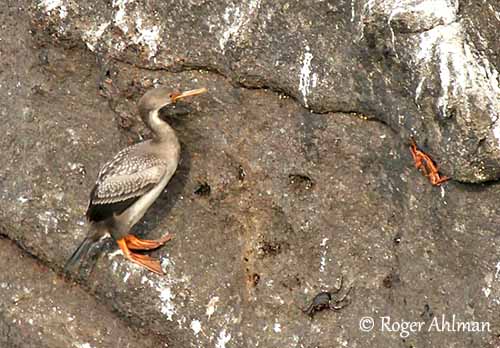
RANGE:
The Red-legged Cormorant occurs along the coasts of S South America. On the Pacific coast, it can be seen from Peru to Chiloe Island in Chile. On the Atlantic coast, some small isolated populations are scattered across Santa Cruz in Argentina.
HABITAT:
The Red-legged Cormorant breeds on steep rocky cliff faces and rocky islets and in sea caves. The foraging areas are mainly in shallow offshore waters.
CALLS AND SONGS: SOUNDS BY XENO-CANTO
The Red-legged Cormorant is silent outside the breeding season. However, at nest, it may produce some vocalizations, usually high-pitched chirrups and squeals.
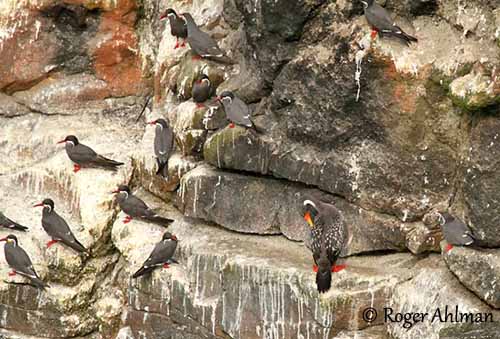
BEHAVIOUR IN THE WILD:
The Red-legged Cormorant spends most of its time at sea. It feeds mainly on fish caught by dive from the surface. It hunts in shallow waters and pursues the preys, fishes and invertebrates, near the sea floor.
It usually feeds alone, and rarely in small groups.
In the same way, the Red-legged Cormorant often nests alone or in small loose colonies. The male arrives first at the nesting site and displays to attract a mate. Mutual preening is usually followed by copulation. The pairs are monogamous at least for one season.
Some aggressive displays can be observed during the territorial defence, with lateral head-quivering and weak gape-thrust. The neck is retracted during these displays.
The seabirds, and especially the Kelp Gull, attack the nests and take both eggs and chicks.
The Red-legged Cormorant is sedentary, but it may occasionally reach the Strait of Magellan.
The flight is powerful with regular wingbeats, sometimes interspersed with glides.
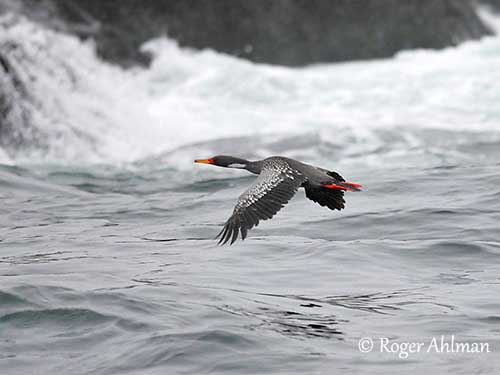
REPRODUCTION OF THIS SPECIES:
The breeding season occurs mainly between October and February, but breeding may occur in all months.
The Red-legged Cormorant nests on narrow ledges on vertical rocky walls, often on sea cliffs, on islets or in sea caves. The nest is made with seaweeds, feathers and guano, but some less natural materials such as plastic debris can be added.
The female usually lays 2-4 white eggs (often 3). Both adults share the incubation during about one month. At hatching, the chicks are naked, but they are quickly covered with dark grey-black down. Bill and eyes are blackish, whereas legs and feet are dull greyish-pink.
They are fed by both parents and are independent 60-70 days after hatching. They remain in family group in their breeding area.
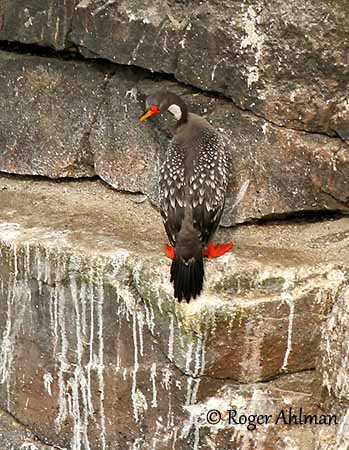
PROTECTION / THREATS / STATUS:
The Red-legged Cormorant has small population estimated at 30,000 individuals in 2007. The numbers are decreasing due to fishing operations and human activities. Hunting and egg-collection is still a problem in some areas. Human developments are increasing and threaten the breeding sites. El Niño also involved dramatic declines in 1997-1998.
The Red-legged Cormorant is currently classified as Near Threatened.
